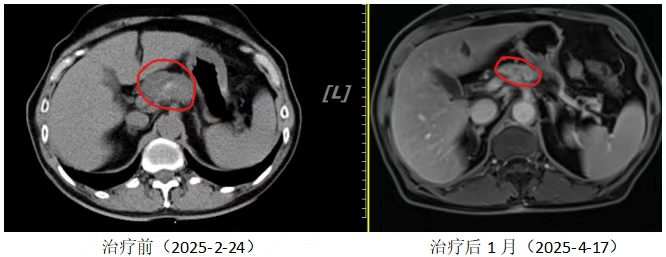Male, 72 years old, pancreatic malignant tumor
[Clinical Summary]
1.Patient: Han XX, male, 72 years old. Chief Complaint: Hospitalized due to "confirmed pancreatic malignancy for 1 month."
2.Laboratory Findings:
Pancreatic cancer tumor markers:
Alpha-fetoprotein (8-HR): 878.6 IU/mL (elevated)
Carcinoembryonic antigen (8-HR): 49.2 ng/mL (elevated)
Carbohydrate antigen CA-50: 28.3 IU/mL (elevated)
CA19-9: 75.2 U/mL (elevated)
CA72-4: 11.3 U/mL (elevated)
CA24-2: 20.1 IU/mL (elevated)
3.Imaging analysis:
- PET-CT: isodense nodule in the leptomeningeal region of the pancreas with unclear borders and metabolic elevation; irregular cystic solid mass above the neck of the pancreas with metabolic elevation; pancreatic cancer with lymph node metastasis was considered.
- Abdominal MRI: cystic solid mass above the neck of the pancreas and adjacent tissues are poorly demarcated, suggesting the possibility of metastatic lymph nodes.
4. Pathological puncture: puncture biopsy of pancreatic mass confirms the diagnosis of adenocarcinoma.
[Clinical diagnosis]
Pancreatic malignant tumour (leptomeningeal, adenocarcinoma, cT2N2M0 stage III, KPS score: 90).
[Treatment plan]
- Carbon ion radiotherapy: total dose 58.5 Gy (RBE)/14Fx.
- Simultaneous chemotherapy: NALIRIFOX regimen (liposomal irinotecan + oxaliplatin + calcium folinate + fluorouracil).
[Therapeutic Response]
Post-treatment tumor markers showed significant decline:
CEA: 16.2 ng/mL (previously 49.2 ng/mL)
CA19-9: 20.4 U/mL (previously 75.2 U/mL)

Left image: Before treatment; Right image: One month after treatment
This case demonstrates the significant efficacy of heavy-ion radiotherapy in the treatment of locally advanced and metastatic pancreatic cancer. Through personalized treatment, the patient exhibited a marked reduction in tumor marker levels and significant imaging improvement.
Moreover, carbon-ion therapy not only demonstrates remarkable tumor suppression during treatment but also exhibits sustained biological advantages post-treatment. This effect allows the tumor to continue shrinking for 3-6 months after therapy, reaching its peak response at 6 months. Due to carbon ions inducing DNA double-strand breaks, their tumoricidal effect is more thorough, effectively reducing recurrence rates and improving local control. This approach provides patients with longer progression-free survival and enhanced quality of life.For patients with locally advanced or inoperable pancreatic cancer, this technology undoubtedly opens a promising therapeutic pathway.
